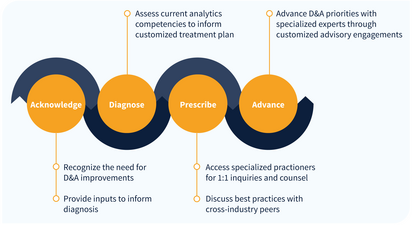Client Inquiry:
How do you tell the value story of a modern data platform that is meant to enable autonomy across an organization? If the intent is to “get out of the middle” of everything, how do we know the value the platform is delivering if we don’t know about every solution leveraging it?
Expert Takeaways:
1. Pull every lever to show the data platform is being used
When building a data platform designed to enable autonomy, it’s not enough to deliver the foundation. As soon as the platform opens to broader use, central teams lose line of sight into how it’s being leveraged—and that makes it harder to communicate value. Leaders need to pull every lever available to keep the platform visible, relevant, and accountable.
- Leverage executive investment. Someone signed off on the platform’s budget. Use that investment as a forcing function: continue asking, “What are we getting for it?” The question doesn’t need to originate from the data team—it can be posed by finance, by program management, or in a company-wide all hands.
- Build coalitions to create consistency. One team can’t define value on its own. Encourage adoption and alignment by forming cross-functional councils or steering groups. Use them to standardize definitions, highlight wins, and ensure visibility of high-impact work.
- Make measurement part of the model. Establish ROI templates tied to common use cases like cost savings or efficiency improvements. Collaborate with finance to endorse the approach. If a structured template feels too rigid, start by celebrating early wins—create a newsletter, gather stories, and track impact. Eventually, peer competition will do the rest.
2. Influence is part of the job, so structure for it
Having the right tactics is a good start, but they only work if the organization buys in. Building a steering committee or reporting value metrics won’t move the needle unless the right people are engaged—and willing to advocate. In a legacy enterprise with a culture of scrutiny and competition, that kind of influence takes ongoing, intentional effort.
- Treat internal advocacy like a capability. Think of influencing as its own stream of work—not just an outcome. Allocate real time and energy to shaping perception, not just building solutions. It may require a reset every 6–12 months to ask: Do we have the right people and skills to carry the message forward?
- Don’t rely solely on technical talent. If your team is heavy on engineering or data science expertise, consider adding relationship-oriented roles—people with experience in consulting, storytelling, or cross-functional leadership. A small number of these roles can go a long way.
- Design for engagement, not just representation. Getting the right names on a council isn’t enough. Focus on finding advocates who will champion outcomes, not just show up. If key stakeholders are passive or protective of business credit, the structure alone won’t unlock value.
3. Stop trying to claim credit and start telling better stories
It’s tempting to quantify the precise ROI of the platform or analytics function—but in a competitive, finance-driven culture, obsessing over attribution can actually backfire. A better approach: measure the business result and highlight how analytics enabled it.
- Make the value visible without over-claiming. Rather than arguing about how much credit the platform deserves, align with finance on the outcome itself—cost savings, margin lift, time reduction—and frame the analytics team as an enabler of that outcome.
- Treat business partners as heroes. When a use case shows real value, bring it to the business leader and let them shine. Help them articulate the win, share it with finance, and give them a story to tell. That goodwill comes back around when priorities are set or resources are allocated.
- Build shared templates and standards. To sidestep unproductive attribution debates, co-develop ROI templates with finance that reflect business realities. You’re not fabricating numbers—you’re framing value in a way that’s consistent, defendable, and widely understood.
- Don’t over-engineer the credit model. Just focus on the business result and a simple before-and-after. Attribution will follow. And if it doesn’t? Make peace with that—because ultimately, it should be a one-team company.
Expert Network
IIA provides guided access to our network of over 150 analytics thought leaders, practitioners, executives, data scientists, data engineers with curated, facilitated 1-on-1 interactions.
- Tailored support to address YOUR specific initiatives, projects and problems
- High-touch onboarding to curate 1-on-1 access to most relevant experts
- On-demand inquiry support
- Plan validation and ongoing guidance to advance analytics priority outcomes
- Monthly roundtables facilitated by IIA experts on the latest analytics trends and developments
